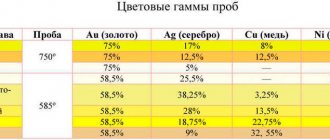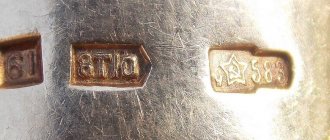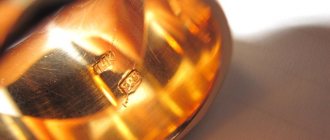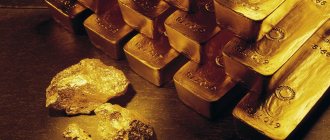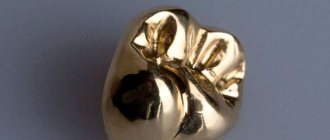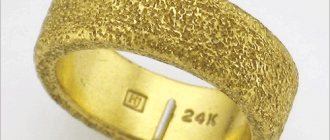The gold alloy contains a certain proportion of this precious metal, the rest being alloys. This variety differs from pure gold in its main properties. In most cases, you can also identify a fake by its external characteristics. A mixture of ligatures and precious metal was widely used in the past and has not lost its popularity today. Modern gold alloys are represented by a large number of types. You can find out how they differ by studying the tables containing the percentages of ligatures.
Pure gold and its characteristics
It is rarely found in its pure form. Mostly it is native gold. There are natural formations that are characterized by large size. Each has its own name, because it is a rare occurrence. But in this form the metal is not used in jewelry, the space industry (when processing satellites), orthopedic dentistry, or industry. The reason is high softness, but strength, on the contrary, is low.
The precious metal is often used to form gold and foreign exchange reserves.
Pure gold
Pure gold is found in the periodic table under atomic number 79. It has the following characteristics:
- atomic mass – 196.966569 g/mol;
- metal density – does not exceed 19.32 g/cm3;
- melting point – 1064.18 °C;
- the precious metal boils at a temperature of 2856°C;
- thermal conductivity – 318 W/m*K.
Au is hard and becomes liquid when combined with mercury (forms an amalgam).
Gold samples in various alloys
A hallmark is a type of mark that determines the weight content of Au in the precious metal. Today in Russia the metric system is used for this. Based on it, according to GOST 30649-99, alloys with special properties and different colors are obtained. The most common:
- 999 or 99.9% - pure gold, the content of precious metal is the highest (but a small percentage of impurities is still acceptable), even fewer additives can only be in a nugget;
- 750 or 75% is a more common option, the amount of Au is significant, which increases the value of jewelry and other products, but this reduces strength;
- 585 or 58.5% is the most popular type of yellow precious metal; it is distinguished by the best ratio of alloys and gold, which allows one to obtain excellent characteristics (high wear resistance, strength, moderate ductility are noted);
- 500 or 50% - the gold content is at the lower limit, which allows the alloy to be classified as precious metals, the strength is higher than that of products of the 585 grade, but the value is lower, which affects the price (products are more affordable);
- 375 or 37.5% is a rarer alloy, but is still used, the Au content is minimal, the value is low, however, jewelry of this type is resistant to mechanical damage, although the price is closer to premium jewelry.
Note: The main types of alloy: copper, silver, platinum group substances, brass and other precious and base metals.
999 standard is the highest standard of gold
What little tricks should you know when choosing jewelry?
Sunlight gold brooch, Tous white gold ring
- A prerequisite is the presence of a sample. A genuine product must have an imprint in the form of a woman in a kokoshnik, next to which there is a set of numbers indicating the content of precious metal (gold or silver) in the alloy. The imprint on Ukrainian gold items is a trident. Imported products must also have a Russian stamp, which means that the imported gold has been tested and meets quality standards.
- When the “golden woman” on the print “looks” to the left, alas, the product can be considered fake. If to the right, then the gold is already 50/50 real.
- Gold with a purity lower than 333 is already considered costume jewelry.
- If you choose a matte decoration, appreciate the uniformity of the matte finish and its velvety appearance.
- Basic information that should be on the tag: manufacturer, name of the product (bracelet, earrings, necklace, etc.) and its article number, purity, weight of the product, cost.
- Drop, for example, a gold ring on the counter or floor, the quality of which you are not sure of. When falling, you should hear a monotonous sound, which indicates the presence of pure gold in the product you are purchasing. When struck lightly on a hard surface, gold should produce a ringing sound rather than a dull sound.
- We determine the quality of the gold weave of the chain - take it and wind it around your finger, and then unwind it again. The unwinding process should proceed without unnecessary effort, and the links should not end up getting tangled or twisted together.
Alloy metals in alloys with gold and their properties
In ancient times, purer gold was often used, but the size of the coins quickly changed with intensive use (they were worn out), so they began to use a different technique for producing the precious metal. Alloys were added and proportions were selected that would make it possible to create a material with the most suitable characteristics: high value and strength. The properties of the additives were taken into account. List of the most common ones:
- silver for softness: the main advantage of introducing such an alloy is the ability to increase malleability, ductility, in addition, the precious metal acquires a lighter shade, when choosing the right ratio it becomes white, but the more silver, the lower the value of the product;
- copper for a red tint: used for the purpose of alloying with gold, allows you to change the Au strength indicator (products better withstand mechanical loads), as well as its color - the precious metal acquires a red tint, unlike silver, by adding a small proportion of copper (14-15%) will make it red;
- nickel for hardness: it is characterized by increased hardness and resistance to corrosion, which allows the precious metal to be used in dentistry and the jewelry industry, the disadvantage is the risk of developing allergies when products come into contact with the skin;
- palladium for refractoriness: to obtain a material of higher hardness, the chemical formula changes - palladium is added, at the same time the cost of the products increases, since this alloy also belongs to precious metals, and also contributes to a change in color to a lighter (white);
- platinum for whiteness: used to change the color of the alloy; it is enough to increase the platinum content to 8.4% to obtain a white precious metal; in addition, the addition of such an alloy contributes to an increase in the elasticity of gold and the melting point, which somewhat complicates the work with products;
- ruthenium for strength: increases the melting point, as a result, to change the shape of the product you need to heat it more, gold becomes stronger, but ruthenium does not affect its shade;
- iridium for wear resistance: it is not used to produce an alloy of a different color, but is used to change the properties of the precious metal, as a result, gold becomes even more elastic than when combined with iridium, products are much less amenable to processing;
- osmium for elasticity: the alloy in terms of the degree of impact has many properties in common with ruthenium, iridium, when such a metal is introduced into the composition, the melting temperature changes - it increases, working with the material becomes more difficult, but elasticity increases, its resistance to deformation, but will not withstand a pinpoint impact ;
- cadmium for fusibility: unlike osmium, iridium and other alloys, cadmium, on the contrary, reduces the melting point of the gold mixture, which makes it easier to work with; the precious metal becomes more ductile, but at the same time fragile, since it does not always withstand mechanical loads exerted during the operation of the product, in addition, the gold alloy changes color slightly - a greenish tint appears, but there are other alloys to obtain such a tone, cadmium more often performs other tasks;
- zinc for a green tint: its properties are similar to cadmium, it also contributes to the appearance of a green color, but by choosing a suitable base (ligature), this disadvantage can be eliminated; in addition, zinc increases the hardness of the material, but at the same time it is easier to damage it, because it increases degree of fragility, with pinpoint impacts the product can be destroyed, in addition, the ligature helps to reduce the melting point;
- aluminum for plasticity and unusual shades of gold alloys: one of the types of alloys used in the production of various precious metals, aluminum is introduced into the composition of the violet-colored alloy.
Interesting: A superhard metal based on Au and Ti (titanium) was recently invented.
Precious metals and impurities
The principle of alloying gold with metals
More suitable for processing is a material that is characterized by ductility, low melting point, and strength. The choice of ligatures and their combination with each other allows you to find the best option, taking into account the given characteristics. When one of the additives is introduced, the composition of the material changes. To correct the result obtained, another additive is introduced. For this reason, the metal may contain 1-2 alloys or more.
Note: The homoizing treatment procedure is carried out in order to increase the degree of homogeneity of the precious metal, the desired result is achieved by reheating to a temperature of +700°C, further holding the alloy improves the structure.
Alloys of various colors of gold
The choice of alloys is made taking into account the properties that they exhibit when combined with Au. At the same time, they do not focus on the characteristics of the metal itself, which acts as an additive. The result of combining precious and non-precious materials:
- yellow is a classic combination of gold, and in addition also copper and silver: the classic version, to obtain a yellow metal, gold must exceed other additives in quantity, a special, more saturated color is obtained thanks to the combination of silver and copper, and it is the latter of the alloys that enhances the depth of color , and silver does not allow increasing the intensity of the red tone;
- red is a popular duet of Au and Cu: a metal of this color began to be used in Russia in the 18th century, a reduced copper content and additional additives (silver) make it possible to obtain rose gold, it is based on a red alloy, but the properties are different, because the ratio components are significantly different;
- white - adding various alloys for an exquisite white color: the metal has a different name - “white gold”, but the main component is still Au, the platinum group metals used as alloys, as well as manganese, nickel, change its classic yellow color, as a result products may have other properties different from those exhibited by platinum jewelry - the fusibility increases, due to which the variety of shapes and designs of jewelry increases;
- black - an alloy as a result of oxidation with the help of cobalt: a ring or bracelet acquires this color if oxidation with cobalt occurred during manufacturing, an alternative option is dressing with the addition of carbon, patination and rhodium plating also imitate a similar color;
- green - the alloy includes gold with a silver alloy: such products have a name - “electrum”, a metal containing a certain proportion of Ag, characterized by a faint green tint, this color is more pronounced if gold is alloyed with cadmium, but such jewelry is not recommended for long wear may cause harm to health;
- blue and blue - a spectacular alloy with indium: not strong enough, so platinum group metals are often added to the composition, indium gives a blue color, and blue gold is an alloy based on iridium;
- purple is a mysterious alloy of gold with aluminum and palladium: a rare combination, therefore it is not found often, this method is mainly used for making inserts, the disadvantage is fragility.
Interesting: in Ancient Greece, the alloy of gold and silver had a specific name - electron.
Gold of different shades
Ways to recognize fake jewelry
First you need to consider the jewelry. It must have a special marking that is responsible for the authenticity of the gold. The hallmark or carat weight must be stamped. To facilitate inspection, it is advisable to use a magnifying glass. It is not always possible to distinguish the mark on antique metal. In the modern world, they have learned how to test gold on fake gold, so this method is not always successful.
Over time, the gold plating wears off. You need to look at the edges of the product. If other metal is visible in the areas of wear, the item is not entirely made of gold.
Checking the product for bite
Previously, films were often shown where gold coins were tested for their “tooth”. And for good reason. After all, this way you can check not only coins, but also gold jewelry. For example, a ring or earring. The product must be pressed with your teeth. Now look at him. Real gold will leave teeth marks. The deeper the bite, the higher the test. However, we must not forget that lead is very soft, so it will also leave traces.
Ceramic check
Fake gold is easy to detect using this method. This test must be carried out very carefully as it is easily scratched. To do this, you will need an unglazed ceramic plate, that is, not covered with anything. Swipe the gold over it with light pressure. What is visible? The gold stripe is a natural product, the black stripe is a fake decoration.
Magnetic check
First you need to purchase a magnet. The one that hangs on the refrigerator is very soft and is not suitable for dough. The magnet must be a real, heavy one that interacts with the metal. Gold is never attracted. Therefore, feel free to bring the jewelry to the magnet. If she is attracted, then you are holding a real fake. There are cases when a magnetically passive component is added to a product. Then you can confuse gold with a fake. How to distinguish gold in such cases? Try the following method.
Application of nitric acid
Nitric acid will help identify fake gold from real gold. To do this, place the product in a metal container without stains. Next, you need to drop nitric acid from a pipette onto the product. If the gold changes color and becomes greenish, then you are conducting an experiment with ordinary metal. The gilded product takes on a milky hue. If the gold is real, then no reaction will take place.
Sound test
If you take a gold item and throw it onto the surface of the table, then the real metal will ring loudly, like crystal. For such an experience, rings, earrings, but not long jewelry (chains, bracelets) are suitable.
Vinegar test
Pour some vinegar into the container and place the decoration there. Nothing bad will happen to real gold, but fake gold will darken in two minutes.
Iodine test
Iodine is a very good test for the authenticity of jewelry. To do this, you only need to apply one drop to the inside of the product. Gold will remain unchanged. The fake decoration will darken. It can turn either light gray or black.
Any chemical testing is possible only on the surface of the jewelry. The inside is checked when a person is ready to destroy the product.
You can also ask experts how to distinguish gold from a fake, who will help you quickly and using several ways to determine whether the jewelry is real. Gilding is almost real metal.
Imitation gold
The metal may not contain Au, but must have similar external characteristics to be considered similar to the original. Such products have no value, but they have a wide range of applications, for example, the production of costume jewelry is the main direction. List of metals that imitate gold alloy:
- bronze: copper with the addition of aluminum, the first component gives a red tint, the second brightens the tone;
- vermeil: silver with gilding, the appearance of Au is preserved, but the products are lighter;
- Hameltonmetal: a method of coating products that was previously often used; the metal contained copper and zinc.
Which jewelry is more reliable?
The durability of these pieces of jewelry mainly depends on the karat of the gold layer, its thickness and the composition of the alloy from which the base is made.
Silver is a soft metal and therefore can be expected to be relatively easy to bend unless the alloy contains other metals to improve its hardness.
Whether a plated item is harder (compared to gold plating) depends on the metals from which it is composed - some jewelry may not be much harder than gilding.
The karat of the gold plating determines whether its surface will scratch easily—high purity gold is softer and less durable, while lower karat alloys do not scratch or wear as easily.
In this regard, a plated item may be more or less durable than gold plating, depending on the gold used for the plating.
In terms of plating thickness, you may have gold-plated jewelry with a thicker layer of gold than plated jewelry, or vice versa.
In any case, the thicker the layer, the longer it will last (provided it is not much softer due to its carats).
As you can see, neither plated nor gold plated jewelry is undisputedly superior when it comes to durability—it just needs to be judged on a case-by-case basis based on the karat of the plating, its thickness, and the composition of the base metal.
Decoding the markings of alloys that contain gold
Materials are marked for ease of handling. For precious metals, in addition to the letter, an additional numerical designation is generally accepted - fractions of thousandths, and for base alloys - hundredths (%). Common options found in GOST:
- gold – Evil;
- silver - Wed;
- platinum – Pl;
- copper – M;
- zinc – C;
- nickel – N;
- cadmium – Kd;
- palladium – Pd.
Medical gold alloy
Known noble metals
Noble metals are gold, silver and platinum, which are known to us mainly from the jewelry industry. They have several derivatives (rhodium, iridium, palladium, ruthenium, osmium), which can also be classified in this category. However, there is no consensus among scientists about the completeness of this list. Thus, a number of researchers believe that technetium also complements noble metals. Its peculiarity lies in its radioactivity.
Jewels have gained this status due to the fact that they are practically not susceptible to corrosion, as well as to the influence of most chemical elements. For jewelry, not only shine and shimmer are important, but also the fact that precious metals practically do not enter into any reactions with the human body, and therefore do not lose their properties over time and do not lead to inflammation and allergic reactions. Their cost also increases due to the fact that they are quite rare in nature.
World systems for measuring the purity of gold precious metals
At different times, a wide variety of methods were used to determine the Au content in a metal alloy. At the same time, the number of ligatures that were added at the manufacturing stage varies: from 10-12% to 80%. But the best option in terms of appearance and properties is the one that contains 30-40% additives. There are only 4 known ways to measure the purity of a precious metal:
- widely used metric system: the fraction of the precious metal is determined in thousandths (range from 0 to 1000);
- carat system, applicable in the USA and Europe: the value taken as a basis is 24 carats, this is a precious metal without impurities; accordingly, the gold content in different alloys is determined as the number of parts of 1/24 of the pure substance (corresponding to 1 carat);
- spool system of Tsarist Russia: the basis was taken as a measure - 96 samples of pure precious metal, corresponding to the number of spools in 1 Russian pound;
- lot system of Old Europe: metal of 16 lots was considered pure; the lower this number, the lower the value of the products.
Determining gold plating
Many consumers are interested in: “how to distinguish gold from gilding?” With the slightest knowledge this is not difficult to do. Usually gold plating is not tested. The gold alloy will not be able to lie on top of the metal. Only real noble metal will fit. If you see a product with hallmarks: 585, 750, 350, 500 - this is gold with added impurities. On pure precious metal there can be only one standard - 999. If gold foil was used, then they can put another standard besides those on real metal.
Important! A sample does not always guarantee the authenticity of a product. Sometimes small scratches can be seen. Often this means that the item is not entirely gold, but only a clasp on or near the item. Everything else may turn out to be gold.
To check the jewelry yourself, you can lightly scrape the product in an inconspicuous area. The gilding will come off slightly, but the gold will remain unchanged.
A lapis pencil is also suitable for checking. It is sold in any pharmacy. The scraping area must be moistened with water and drawn over it with a pencil. Any metal other than gold will darken.
A simple experiment can be done to test gold. Turn on the burner and heat the product over it (300-400 degrees). Then quickly throw it into cold water. Gold will not change, but stains will appear on other metals.
You should never purchase gold from dubious establishments and stores. These should be specialized jewelry departments, where there are quality certificates and specialists work. After all, some unscrupulous sellers refer to the fact that samples are not taken abroad. You can't believe this. Any import of gold jewelry is not permitted without a stamp and relevant documents.
Sometimes you come across products that have the 583rd mark on them. Many people don't know about it. These jewelry were made in Soviet times and fakes of such products are extremely rare. Therefore, if you come across a 583 sample, do not be alarmed.
How alloys can change the appearance of a product
According to GOST, the difference between metals of the same group can be small or significant. However, the gold content in the alloy is always the same, despite the change in the proportions included in the composition of the alloys. The shade changes when the amount of basic additives varies: silver, copper, which determines the depth of color.
Table 1: Alloys with Au in the composition, 375 samples
Metal based on Ag, Au, Cu is presented in the following options:
| Au, % | Ag,% | Cu,% |
| 37,2-37,8 | 1,5-2,5 | 59,5-61,5 |
| 9,5-10,5 | 51,5-53,5 | |
| 15,5-16,5 | 45,6-47,4 |
Gold purity 375
Table 2: Alloys that contain Au 500 grade
| Gold, % | Silver, % | Copper, % |
| 49,7-50,3 | 9,5-10,5 | 39,2-40,8 |
| 19,5-20,5 | 29,2-30,8 |
Table 3: Au 583 alloys
| Gold, % | Silver, % | Copper, % |
| 58,0-58,6 | 7,5-8,5 | 32,9-34,5 |
| 19,5-20,5 | 21,1-22,3 | |
| 29,5-30,5 | 11,2-12,2 |
Table 4: Au 585 based alloys
| Au, % | Ag,% | Cu,% |
| 58,5-59,0 | 7,5-8,5 | 32,5-34,0 |
| 19,5-20,5 | 20,5-22,0 | |
| 29,5-30,5 | 10,5-12,0 |
Hallmark 585
Table 5: 750 grade alloys
| Au, % | Ag,% | Cu,% |
| Au, % | Ag,% | Cu,% |
| 74,7-75,3 | 12,0-13,0 | 12,0-13,0 |
| 14,5-15,5 | 9,5-10,5 |
Table 6: 958 alloys
| Au, % | Ag,% | Cu,% |
| Ag,% | Ag,% | Cu,% |
| 95,5-96,1 | 1,5-2,5 | 1,7-2,5 |
Jeweler's comment
Molokanov N.M.
Jeweler, 26 years of experience in jewelry production.
The content of the alloy makes the metal different from others. Today, the composition is often changed, according to GOST, as a result of a decrease/increase in the proportions of gold, copper, silver or other metals, which can affect strength, density, fusibility and, of course, color. Thanks to this feature, the shade of precious metals serves as one of the signs of authenticity.
